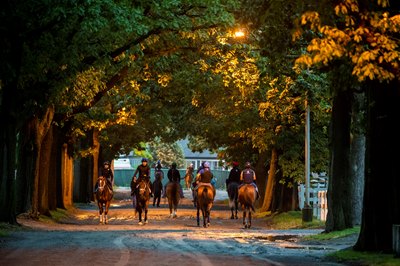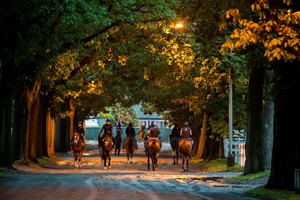What's Going On Here: NYRA's Belmont Park Plan a Winner


In the past 14 years major sports teams have constructed or significantly overhauled five stadiums or arenas in New York City—needed efforts as teams attempt to compete for fans' dollars.
As for racing in the United States, Churchill Downs has taken a similar approach with its facility, upgrading amenities that have allowed the Kentucky Derby (G1) to thrive and become an important economic driver for everything else the track does.
Similar to Churchill on the racing side, and the other sports venues in its region, the New York Racing Association has a plan in place for the home of the final leg of the Triple Crown, Belmont Park. It's a plan that would see the current large warehouse-like grandstand—once exactly what sports and racing venues wanted—give way to a facility that would deliver today's expected fan amenities, not to mention an inviting atmosphere that would emphasize the considerable green space in Elmont, N.Y. that serves as a dramatic counterpoint to the urban sprawl that surrounds it.
"We're trying to put the 'park' back into Belmont Park," said New York Racing Association president and CEO David O'Rourke.
To carry out this vision, NYRA is asking for a $455 million loan from the state—a loan that has been included in Gov. Kathy Hochul's 2024 fiscal year budget proposal that awaits approval by lawmakers ahead of an April 1 deadline. BloodHorse hopes state lawmakers approve the loan, a move that would allow NYRA to compete for fans in the modern era, ensure a year-round racing circuit, and generate revenue.
Incredibly, it would accomplish all this while immediately returning dividends to the state. That's because as part of the plan, racing at Aqueduct Racetrack would be abandoned and its dates would move to Belmont. This would free up 110 acres of state-owned, prime New York property. Largely open space in New York is rare; the value of this plot is a cool billion dollars. (NYRA conducts its racing on state-owned properties.)
Other returns would include 3,700 construction jobs, and then 744 new full-time jobs. NYRA projects a $1 billion economic impact for the project that would bring long-term benefits to the state's racing, breeding, agriculture, and tourism industries. That's thousands of jobs directly dependent on the success.
"We throw out a lot of numbers in telling our story in terms of the jobs that are produced and the economic impact and they're all valid reasons for the project, but personally, from our management team, there's thousands of families tied into just our circuit," O'Rourke said. "Getting Belmont's future secured. That's a lot of weight."
O'Rourke recently was asked about attending hearings and the pressures of answering questions fired off by lawmakers. He noted that, compared with what's at stake, it's a welcomed burden.
"The most stressful part for me isn't answering these questions we've been answering—we can answer all these questions," O'Rourke said. "The pressure is people depend on us executing this for their futures. To have a platform—the track—that works for everyone is fundamental to what they've dedicated their lives to—the craft of horsemanship. So that's who we're getting this done for."
When compared with the sometimes dizzying amounts of public money awarded to ensure the construction of sports or entertainment venues in recent decades, NYRA isn't asking for much in its planned overhaul of Belmont. InvestigativePost.org reported in February that the five new or renovated stadium or arena projects in New York received $2.3 billion in local, state, and federal money. Granted, that same story noted the state contributed just $379 million to the total costs of $6.4 billion, but keep in mind that the NYRA funding is a loan. The plan is to pay it back.
As for other returns from the first update to NYRA's workhorse track in more than half a century, there would be many. Breeders' Cup would add a new Belmont to its regular rotation for its World Championships. The most recent economic studies conducted by Breeders' Cup found a $97 million impact for the San Diego area in 2017 at Del Mar and a $74 million impact for the Louisville, Ky., area in 2018 at Churchill. It's pretty safe to say a $100 million impact would be enjoyed in the New York area from the international event.
"As you know, Breeders' Cup views New York and New York racing as playing a critical role in the ongoing growth and success of Thoroughbred racing in the United States," said a recent letter signed by Breeders' Cup chair Barbara Banke and president and CEO Drew Fleming. "Returning the Breeders' Cup World Championships to Belmont Park would not only serve to highlight that vital function but would also provide an extraordinary venue for all our participants both domestic and international. Simply put, it has been far too long since the Breeders' Cup World Championships have been held in New York and the only hurdle is the existing infrastructure at Belmont Park.
"We stand ready to support the efforts to build a new Belmont Park and look forward to the opportunity to partner with NYRA and New York to showcase the leading role of New York racing to the world."
O'Rourke said it's encouraging to see some state lawmakers realize that under the plan for a new Belmont, racing would be bringing its "version of the Super Bowl" to New York every few years.

New Approach
That new Belmont Park would be a venue that would offer something for core fans as well as the masses that would show up for the Belmont Stakes (G1) or Breeders' Cup.
The current grandstand was built to serve the larger everyday crowds that once turned out on-track, specifically to facilitate wagering. But as everyday handle has shifted off-track—and even on-track patrons use their phones to wager—the facility has become outdated. Also, NYRA found that some of that once state-of-the-art infrastructure to facilitate wagering makes it difficult to just renovate the current structure. Considering all that NYRA is aiming to accomplish with the new facility, it's less expensive to build a new facility.
"The first thing we thought of was, 'Can we just retrofit this thing? But it just became more expensive to try that than it was just to start over," O'Rouke said. "When you start over, you get to get it right from the beginning."
The current facility isn't providing the experiences fans look for on big days or even the comforts on-track regulars expect. NYRA officials said their research indicates that at 1.2 million-1.3 million square feet, Belmont Park is currently the largest sporting structure in the country without a single luxury box. A new facility would most assuredly include those luxury boxes and more amenities for a day of racing. Stadium-style seating would give way to more dining areas and comforts for frequent attendees.
Racing has always been the most sociable of sports and the new facility will aim to make spending four or more hours at the track enjoyable—especially during that downtime between races.
"As for the building, there will be amenities for today's customer," O'Rourke said. "And it will be expandable; that would all be in the plan. You'd already have the expandable layout baked into the facility. It's not that much different than what they're attempting to do at Pimlico Race Course where you can scale up for big events.
"We'll have a great facility for the 5,000 to 10,000 people who turn out on a Saturday in a park-like setting. That's going to be a cool experience. But on days that you have 50,000-100,000 people for a major Triple Crown event or the Breeders' Cup? We'll be able to serve both and they both have to be unique experiences.
"This is doable. It's just hard to do now when you have a massive warehouse-like building just taking up the entire stretch."

Building from the ground up will allow NYRA to think about today's on-track fan.
"I don't think you'll see much stadium-style seating like we saw at older tracks," O'Rourke said. "It's different now. Our racing events are kind of unique where it's a long day, which is a good thing, but you want to be able to get up and move around. So we'll be thinking about how people in the facility can circulate from the paddock to the front side. These are all things we can contemplate now since we're building from the ground up now."
With winter racing shifting to Belmont, at least some areas of the track will be indoors—including a new simulcast area or areas. A tunnel to the 45-acre infield also will accommodate big days as well as community events.
While the new facility keeps fans in mind, NYRA's overall plan aims to work for horsemen, who will enjoy new racing surfaces including a synthetic track for winter racing. Over the years there has been talk of closing Aqueduct. This plan carries that out but adds an alternative. Aqueduct would end racing but those dates—including the winter dates—will shift to Belmont Park. It's a plan that aims to ensure that year-round racing in the state continues, which benefits horsemen and state breeding.
Also included in the plan is the largest housing construction and renovation project ever for NYRA's backstretch workers at Belmont.
O'Rourke even noted that as NYRA has fallen out of the Breeders' Cup rotation, New York horsemen have had to hit the road for the World Championships each year. They would now enjoy some home games for the event that often decided titles.
Keeping horsemen in New York all season helps ensure that the all-important meet at Saratoga Race Course thrives, as well as the spring and fall meets at Belmont.
"It's important for us to keep the continuity throughout the year for the New York breeding program, one; and our own New York-based horsemen, two," O'Rourke said. "It's just important to keep that (year-round racing) going for the flywheel, the engine.
"We're a big nonprofit. As a trustee we've stayed out of debt and we have tons of stakeholders, but the horsemen are our core community," O'Rourke said. "And that's why we're doing it."

Bottom Line
As a horse racing industry publication, BloodHorse of course supports the project that would benefit New York racing, and, in turn, racing overall. But we're also confident that the more state lawmakers look at the plan, the more they'll like it. NYRA has shown an ability in recent years to deliver big projects on time and up to expectations—take one look at the 1863 Club and paddock suite completed in recent years at Saratoga.
"And from the state's point of view, with Aqueduct (being freed up for a new use), that's a huge value you're just pulling out of the franchise. Then redeveloping Belmont Park into something that's going to drive new events like the Breeders Cup to come and proven events like the Triple Crown—the Belmont Stakes," O'Rourke said. "By downsizing that building, you're also opening up opportunities for that campus to really work well because with the arena there, there's so much potential. They're already opening a high-end mall across the street. There's going to be a lot of activity on this site, a lot of potential for growth."
It's time to bring that potential to fruition, with the next step being approval by state lawmakers.
